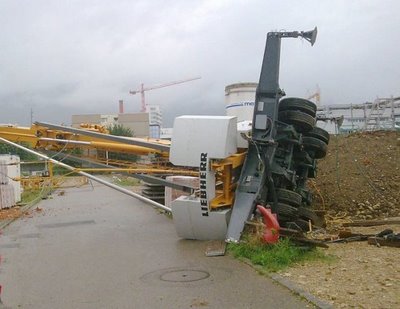Lattice_Boom_Cranes (Download)
Lattice Boom Cranes http://www.biztrademarket.com/User/182617/bb/pr70-crawler-crane_cdh.jpg 1 Lattice Boom Cranes Specific type of mobile crane used in construction Identifiable by a boom that is composed of a web-like structure Typically taller than alternative hydraulic type mobile cranes http://img.directindustry.com/images_di/photo-g/crawler-crane-403618.jpg Lattice Boom Vs. Hydraulic Boom 2 A Brief History of Cranes Greeks are credited with the first use of cranes in the 6 th Century B.C. Animal powered using wooden booms and pulleys The use of cranes for construction in the modern era began in the 13 th Century Increased lifting capacities through stone towers The Industrial Revolution lead to the beginnings of the Lattice Boom Crane in the 18 th Century Iron and steel booms powered by steam engines http://www.prlog.org/10529150-use-and-history-of-cranes.html http://en.wikipedia.org/wiki/File:Roemerkran.jpg 3 Lattice Boom Cranes in the 21 st Century On wheels or tracks Small cranes to a constantly increasing upper limit exceeding 1500 tons Booms made of high-strength steel alloys forming lattice shapes Powered by combustion engines and hydraulics http://www.powerequipco.com/content.asp?page_id=686&uid=&siteid=4 http://fortune-group.en.made-in-china.com/ 4 Uses Lifting large loads to otherwise unattainable heights Moving material and structures around construction projects Supporting caisson and pile driving equipment http://img.directindustry.com/images_di/photo-g/lattice-boom-crawler-crane-117869.jpg http://www.fhwa.dot.gov/engineering/geotech/pubs/gec8/images/f031.gif 5 Typical Hazards Electrical Shock Overhead Falling Objects Cable Wear & Failure Pinch Points Improper Loading Boom Failure http://i.dailymail.co.uk/i/pix/2008/05/30/article-1023080-016E32ED00000578-903_468x292_popup.jpg 6 Fatalities Involving Lattice Boom Cranes Based on 32 OSHA investigated fatalities from 1990 thru 2007 *Source: Extracted from OSHA Accident Investigation Data 1990-2007 7 Industry Facts Each year, more than 20% of eqtipment -related injuries and fatalities involve cranes In addition, crane accidents are costly and cause hundreds of thousands of dollars in damages each year http://www.strw.leidenuniv.nl/~ruvisser/nmo/images/storm070118b.jpg www.osha.gov 8 Past Accidents 3 Ironworkers lost their lives in Milwaukee, Wisconsin Lift included a 450 ton section of roof Weight of the hoisted load, side loads from wind, and out-of-level ground conditions combined to tip the crane as it rotated with the load http://www.millerparkscrapbook.org/images/Photos/1999/accident/updkrf0899b.jpg 9 Past Accidents An Ironworker lost his life A crane supported a beam to be connected to the outside of a stairway With the worker sitting on the beam, the crane operator raised the beam 1 foot, causing the worker to slide off The worker was wearing a safety belt but was not tied off. He fell 45 ft. and suffered fatal injuries *Source: Extracted from OSHA Accident Investigation Data 1990-2007 http://s3.images.com/huge.71.357585.JPG 10 Past Accidents 1 Concrete worker lost his life and 3 more were injured A crane supported a concrete bucket above a bridge deck While pouring the concrete, the lattice boom fell without warning The worker was struck by the falling structure and was pinned between the boom and a concrete screed machine, suffering fatal injuries *Source: Extracted from OSHA Accident Investigation Data 1990-2007 http://media1.delhi.88db.com/del/DB88UploadFiles/2009 /04/08/745F64FD-75D0-4DC9-A8F3-6ED6D1B07CA7.jpg 11 Past Accidents 1 Worker lost his life A truck-type crane supported a load guided by the worker The boom contacted a 13 kilovolt overhead power line The worker was electrocuted instantly *Source: Extracted from OSHA Accident Investigation Data 1990-2007 http://www.osha.gov/SLTC/etools/construction/electrical_incidents/cranefire.html 12 OSHA Regulations Pertaining to Lattice Boom Cranes Subpart N: 1926.550 Cranes & Derricks (a) 1. The employer shall comply with the manufacturer’s specifications and limitations applicable to the operation of any and all cranes and derricks. Where manufacturer’s specifications are not available, the limitations assigned to the equipment shall be based on the determinations of a qualified engineer competent in this field and such determinations will be appropriately documented and recorded. http://image.made-in-china.com/2f0j00KevtiAJMGqbW/QUY450-Crawler-Crane.jpg 13 (a) 7. Wire rope is to be taken out of service when any of the following conditions exist: Six randomly distributed broken wires in one lay of the rope 3 broken wires in one strand in one lay of the rope Wear of 1/3 of the original diameter of the outside individual wires Evidence of heat damage Reduction in nominal diameter of 1/64” for 5/16” rope (1/32” for ropes 3/8” to 1/2”) OSHA Regulations Pertaining to Lattice Boom Cranes http://farm3.static.flickr.com/2665/3989052373_d0ef512f37.jpg 14 (a) 14. ( i ) Fire extinguishers rated 5BC or higher must be available at all operator stations or cabs of equipment (a) 15. ( i ) All parts of the crane and load shall maintain a minimum clearance of 10 feet from power lines rated 50 kV or below (a) 15. (ii) For every 1 kV over 50 kV, an additional 0.4 inch of clearance shall be maintained OSHA Regulations Pertaining to Lattice Boom Cranes 15 Additional Safe Practices Careful pre-task planning before every lift to assure the consideration of all potential hazards Use of personal protection equipment (PPE) http://www.mark-douglas.co.uk/sitebuildercontent/sitebuilderpictures/ppe.jpg 16 Additional Safe Practices Assure outriggers are on solid ground sufficient to stabilize the crane and blocking and cribbing are used when necessary Maintain 3 points of contact between hands and feet while entering the vehicle http://www.ditzj.de/assets/images/knuckle/dsb3000/dsb3000_06.jpg http://www.elcosh.org/record/document/96/4.jpg 17 Additional Safe Practices Perform inspections on all machinery and equipment prior to each use. Any worn, damaged, or deficient parts must be repaired or replaced before use continues During the operation of any lattice boom crane, spotters should be used to assure safe distances and that no worker is under any load unnecessarily http://www.tpub.com/content/administration/14067/css/14067_103.htm 18 Additional Safe Practices Never exceed safe limits for lifts and move suspended loads slowly Never operate cranes in inclement weather or excessive winds http://4.bp.blogspot.com/_g6x7iYOa_7o/SmM9j3JjI_I/AAAAAAAABV0/dAtK1F_ePEc/s400/Swiss+Liebherr+MT.jpg 19 Think Safety Work Safely 20

